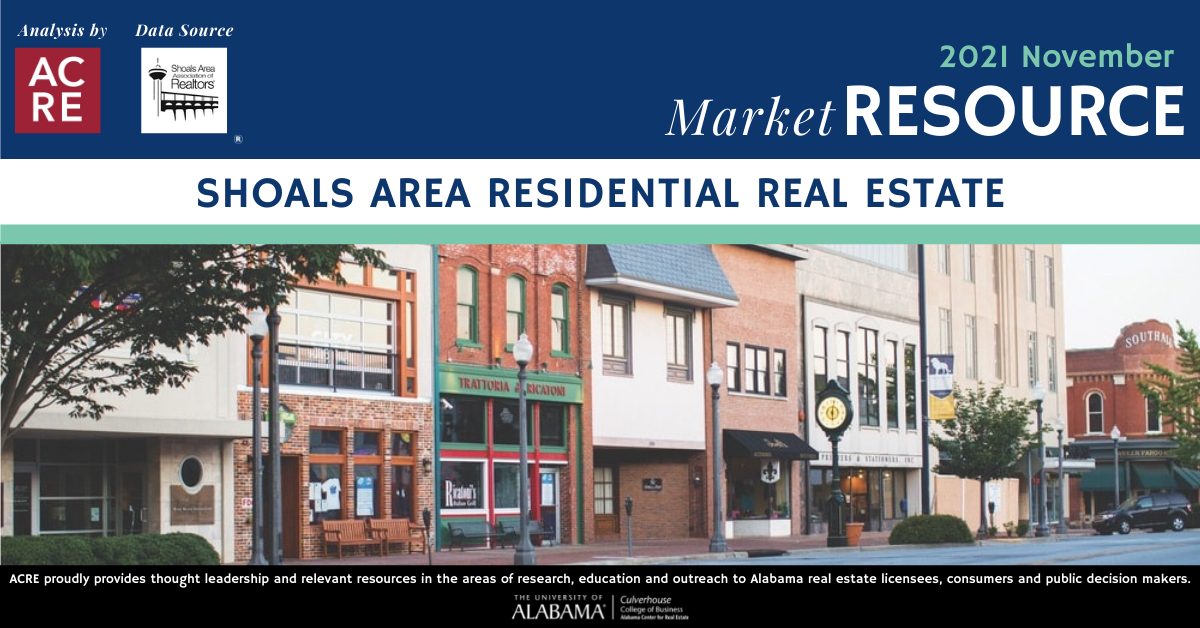Sales: According to the Shoals Area Association of Realtors, November residential sales (203) were equal to one year ago. Following seasonal trends, sales decreased 4.3% from October. Sales are now up 5.4% year-to-date. Two more resources to review: Quarterly Report and Annual Report.
For all of the Shoals Area’s housing data, click here.
Inventory: November listings (297) stayed the same from October and decreased 10.8% from one year ago. At the current sales pace, all the active inventory on the market would sell in 1.5 months, up from 1.4 month in October and down from 1.6 months in November 2020. The equilibrium point where buyers and sellers have roughly equal bargaining power is 6 months of supply.
Pricing: The area’s median sales price in November was $189,600 an increase of 11.5% from one year ago and an increase of 8.0% from October. The differing sample size (number of residential sales of comparative months) can contribute to statistical volatility, including pricing. ACRE recommends consulting with a local real estate professional to discuss pricing, as it will vary from neighborhood to neighborhood.
Homes sold in November averaged 41 days on the market (DOM), 2 days faster than November 2020.
Forecast: November sales were 15 units, or 7.0%, below the Alabama Center for Real Estate’s (ACRE) monthly forecast. ACRE projected 218 sales for the month, while actual sales were 203 units. ACRE forecast a total of 2564 sales in the area year-to-date, while there were 2435 actual sales through November, a difference of 5.0%.
NAR Commentary: According to the National Association of Realtors (NAR), existing home sales increased 1.9% month-over-month in November, marking the third consecutive month of gains (seasonally adjusted annual rate). However, November sales decreased 2.0% from one year ago. The median sales price for all housing types was $353,900, rising 13.9% year-over-year and marking 117 consecutive months of year-over-year gains. Rising home prices are largely a result of low housing inventory amid sustained demand. Supply retreated in November, down 9.8% from October 2021 and down 13.3% from one year ago. November’s 2.1 months of supply (MOS) was down month-over-month and year-over-year.
Lawrence Yun, chief economist for NAR said, “Determined buyers were able to land housing before mortgage rates rise further in the coming months. Locking in a constant and firm mortgage payment motivated many consumers who grew weary of escalating rents over the last year.”
Yun added the following about mortgage rate increases, “Mortgage rates are projected to jump in 2022, however, I don’t expect the imminent increase to be overly dramatic.”
NAR forecasts the 30-year fixed rate mortgage to average 3.7% during 2022.
Yun also said that inflation and home price gains are expected to moderate next year. “Supply-chain disruptions for building new homes and labor shortages have hindered bringing more inventory to the market,” said Yun. “Therefore, housing prices continue to march higher due to the near record-low supply levels.”
ACRE Commentary: Home sales in Alabama rebounded in November, rising 7.8% from one year ago and bringing the year-to-date gain to 11.1%. Nineteen of the 24 markets reporting sales data to ACRE reported sales gains from one year ago.
The statewide median sales price gained 13.1% Y/Y in November, up from 11.3% in October and 9.5% in August. Price growth has accelerated as supply trended downwards in recent months. Properties listed for sale declined 5.0% from October and 24.4% from one year ago. Unsold inventory is at 1.6 months of supply, down from 1.7 in October and down from 2.3 months in November 2020.
Click here to view the entire monthly report.
The Shoals Area Residential Monthly Report is developed in conjunction with the Shoals Area Association of Realtors.
Editor’s Note: All information in this article reflects data provided to the Alabama Center for Real Estate for the time period November 1 – 30, 2021. Thus, the performance represented is historical and should not be used as an indicator of future results.





